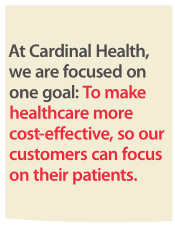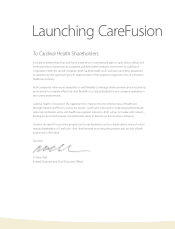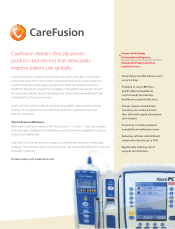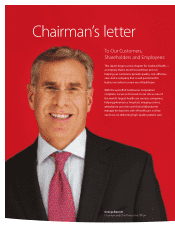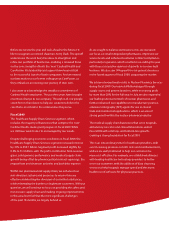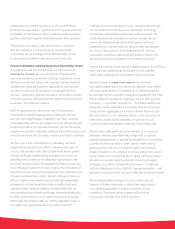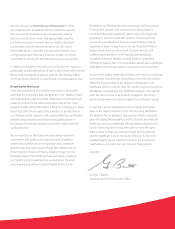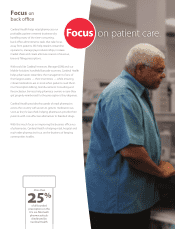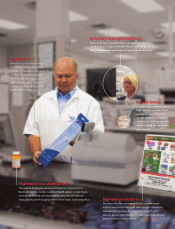Cardinal Health 2009 Annual Report Download
Download and view the complete annual report
Please find the complete 2009 Cardinal Health annual report below. You can navigate through the pages in the report by either clicking on the pages listed below, or by using the keyword search tool below to find specific information within the annual report.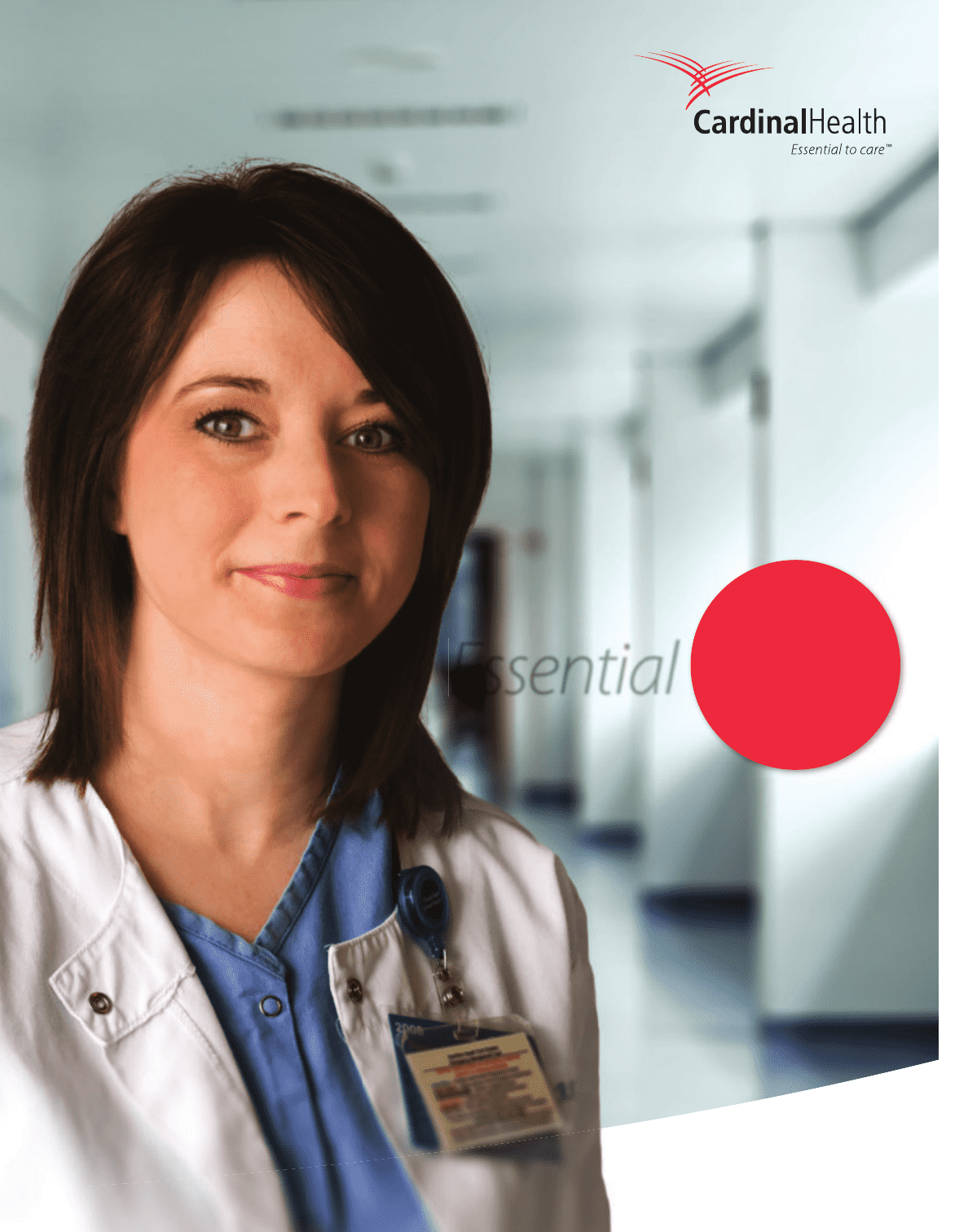
annual report
Essential Focus
Table of contents
-
Page 1
Essential Focus 2009 annual report -
Page 2
At Cardinal Health, we are focused on one goal: To make healthcare more cost-effective, so our customers can focus on their patients. -
Page 3
By helping pharmacies, hospitals, laboratories, physician offices and ambulatory care centers improve their efficiency and collaborate across the healthcare system, we make it possible for our customers to focus on their patients. As the business behind healthcare, we improve the cost-effectiveness ... -
Page 4
... To Cardinal Health Shareholders: It is hard to believe that it has only been a year since we announced plans to spin off our clinical and medical products businesses as a separate, publicly traded company, now known as CareFusion Corporation. With the spinoff complete, both Cardinal Health and... -
Page 5
...patient care globally. CareFusion's family of products and services are used in more than 120 countries and include some of the most widely recognized brand names in their categories: Pyxis® for medication and supply management, Alaris® for medication infusion, AVEA® and Pulmonetic Systems™ for... -
Page 6
... the world's largest healthcare services companies, helping pharmacies, hospitals, imaging centers, ambulatory care sites and clinical laboratories manage the business side of healthcare, so they can focus on delivering high-quality patient care. George Barrett Chairman and Chief Executive Officer -
Page 7
...for use in clinical trials and commercial applications, which is an area of strong growth within the nuclear pharmacy industry. The medical supply chain businesses that serve hospitals, ambulatory care sites and clinical laboratories ended fiscal 2009 with solid top- and bottom-line growth, creating... -
Page 8
... our annual Retail Business Conference for independent pharmacies. We launched several exciting new programs to help our customers more effectively market their stores, improve the profitability of their front-of-store operations and provide value-added services through specialized care centers. We... -
Page 9
...for good growth, with a differentiated portfolio of self-manufactured products, unmatched channel breadth, a broad range of compelling offerings in supply chain services and specialized sales capabilities dedicated to the unique needs of our diverse set of customers. As one of the largest healthcare... -
Page 10
..., increase market share and create alternate sources of revenue, beyond filling prescriptions. With tools like Cardinal Inventory Manager (CIM) and our Mobile Solutions handheld barcode scanners, Cardinal Health helps pharmacies streamline the management of one of their largest assets - their... -
Page 11
...-margin, private brand products, Cardinal Health enables pharmacy retailers to diversify revenue streams while helping their patients save money. Pharmaceutical distribution: Through its 23 pharmaceutical distribution centers and its National Logistics Center, Cardinal Health delivers customized... -
Page 12
... on an efficient supply chain, we enable our hospital, physician office and free-standing surgery center customers to focus on delivering patient care. Cardinal Health offers the most comprehensive selection of products, services, technology and logistics management options specially designed for... -
Page 13
... vaccines, controlled substances and other commonly used pharmaceuticals in ambulatory care centers. Medical supplies and physician o ce equipment: Cardinal Health is one of the largest distributors of medical supplies in the U.S. and offers providers everything from table paper to the exam tables... -
Page 14
.... Our market-leading products and innovations, including Tiburon™ surgical drapes, gowns and masks, Esteem® surgical gloves, Endura™ scrubs and the new ORwell™ uid management system, help support our hospital and surgery center customers' efforts to reinforce compliance with infection... -
Page 15
... on the market. Surgical gowns: Cardinal Health surgical gowns including the breathable and fully impervious AAMI Level 4 SmartGownâ„¢ - provide the highest level of protection from infection while improving comfort for the surgeon. Surgical gloves: Gloves from Cardinal Health protect the... -
Page 16
... from hundreds of manufacturers into site-specific deliveries to retail pharmacies, hospitals, mail-order facilities, physician offices, surgery centers and long-term and other $87.9 billion Segment profit: alternate care facilities. Through this segment, Cardinal Health offers the most... -
Page 17
... delivering medical-surgical products to ambulatory care centers, physician offices, clinical laboratories and hospitals across the U.S. and Canada, the Cardinal Health Medical segment also manufactures $8.2 billion Segment profit: high-volume replenishable products such as gloves, gowns, surgical... -
Page 18
... healthcare. Shareholders The Cardinal Health decision to spin off its clinical and medical products businesses is a strategic one that is expected to benefit the company and its shareholders by allowing each business to focus on its unique growth strategies, capital needs and customer requirements... -
Page 19
... its resources to raise awareness of the growing problem and help combat the issue. Environment Cardinal Health continues to focus on innovative ways to lessen its environmental footprint. In March 2009, the company celebrated the opening of its West Campus building at its Dublin, Ohio, headquarters... -
Page 20
... segment Chief Customer Officer Carole S. Watkins Chief Human Resources Officer Board of directors Colleen F. Arnold (A) General Manager, GBS Strategy, Global Consulting Services and SOA Solutions, Global Industries and Global Application Services International Business Machines Corporation... -
Page 21
... File Number: 1-11373 CARDINAL HEALTH, INC. (Exact name of registrant as specified in its charter) OHIO (State or other jurisdiction of incorporation or organization) 31-0958666 (I.R.S. Employer Identification No.) 7000 CARDINAL PLACE, DUBLIN, OHIO (Address of principal executive offices... -
Page 22
...Disagreements With Accountants on Accounting and Financial Disclosure ...Controls and Procedures ...Other Information ...PART III Directors, Executive Officers and Corporate Governance ...Executive Compensation ...Security Ownership of Certain Beneficial Owners and Management and Related Stockholder... -
Page 23
... statements." This includes, in particular, "Item 7-Management's Discussion and Analysis of Financial Condition and Results of Operations" of this Form 10-K as well as other portions of this Form 10-K. The words "believe," "expect," "anticipate," "project," "will," "could," "would," and similar... -
Page 24
... and exam gloves, surgical drapes and apparel and fluid management businesses that were previously part of its Clinical and Medical Products segment. On July 10, 2009, the Company's Board of Directors approved the distribution to its shareholders of 80.1% or more of shares of CareFusion common stock... -
Page 25
... chain customers order more efficiently, contain costs and monitor their purchases. In addition, the pharmaceutical supply chain business provides services to branded pharmaceutical manufacturers, including distribution services, inventory management services, data/reporting services, new product... -
Page 26
..., the Company's pharmaceutical supply chain business generates gross margin primarily to the extent that the selling price to its customers, net of customer discounts, exceeds in the aggregate, the cost of products sold, net of manufacturer cash discounts, distribution service agreement fees... -
Page 27
... as single-use surgical drapes, gowns and apparel, exam and surgical gloves and fluid suction and collection systems; respiratory care products, such as ventilation equipment and supplies; and medical specialties products, such as reusable surgical instruments and biopsy needles. This segment also... -
Page 28
... to Reportable Segments For Fiscal 2010 Effective July 1, 2009, the Company changed its reportable segments to three segments: Pharmaceutical, Medical and CareFusion. The Pharmaceutical segment encompasses the businesses previously within the Healthcare Supply Chain Services segment that distributed... -
Page 29
... and strategic fit of its businesses and may decide to sell a business or product line based on such an evaluation. See "Spin-Off of CareFusion Corporation" above for information on the Company's plans to spin off CareFusion on August 31, 2009. In addition, during the fourth quarter of fiscal 2009... -
Page 30
... segment's nuclear pharmacies compete based upon a variety of factors, including price, quality, customer service, raw material availability, proprietary technologies or capabilities and responsiveness. The Healthcare Supply Chain Services segment's medical supply chain business faces competition... -
Page 31
Clinical and Medical Products Segment The Company's Clinical and Medical Products segment faces competition in both its domestic and international markets. Its infusion and respiratory products compete based upon quality, technological innovation, price, brand recognition, patents and other ... -
Page 32
... and location of product distribution, manufacturing and sale. These subsidiaries include those that distribute and/or engage in logistics services for pharmaceuticals (including certain controlled substances) and/or medical devices; manage or own pharmacy operations including retail, hospital... -
Page 33
... business. In addition, the international manufacturing operations that reside primarily within the Company's Clinical and Medical Products segment are subject to local certification requirements, including compliance with domestic and/or foreign good manufacturing practices and quality system... -
Page 34
... within its pharmaceutical supply chain business as required by the settlement, including requirements that wholesale customers certify their compliance with wholesaler safe product practices established by the Company. In connection with the settlement, the Company agreed to conduct annual agreed... -
Page 35
...declines in the Company's gross margin. There can be no assurance that the changes in the reimbursement formula and related reporting requirements and other provisions of the DRA will not have an adverse effect on the Company's business. Health Information Practices Services and products provided by... -
Page 36
... Chain Services and Clinical and Medical Products segments to maintain sufficient inventory to meet emergency demands. The Company does not believe that the requirements contained in these U.S. government supply contracts materially impact inventory levels. The Company's customer return policies... -
Page 37
... wholesale distributors, self-warehousing retail pharmacy chains, direct selling manufacturers, specialty distributors, generic pharmaceutical telemarketing distributors and third-party logistics companies, among others. The Company's medical products distribution business encounters competition... -
Page 38
... financial condition. In recent years, a significant portion of the Company's revenue growth has been derived from a limited number of large customers. The Company's largest customers, CVS and Walgreens, accounted for approximately 21% and 23%, respectively, of the Company's revenue for fiscal 2009... -
Page 39
...deflation in generic pharmaceutical prices which subjects the Company to risks and uncertainties. The Company continues to generate a portion of its gross margin from the sale of some manufacturers' products from pharmaceutical price appreciation without receiving distribution service agreement fees... -
Page 40
...items from numerous distribution centers; receive, process and ship orders on a timely basis; manage the accurate billing and collections for thousands of customers; process payments to suppliers; and facilitate the manufacturing and assembly of medical products. The Company's results of operations... -
Page 41
... the second half of fiscal 2009, which affected the financial results of the Clinical and Medical Products segment during the period. The Company expects this delay will have an adverse impact on the financial results of CareFusion through the middle of calendar year 2010. If customers' cash flow or... -
Page 42
... management or employees of the acquired company or the Company's employees following an acquisition; accounting issues that could arise in connection with, or as a result of, the acquisition of the acquired company, including issues related to internal control over financial reporting; regulatory... -
Page 43
... Risk of Non-Consummation. The Company expects the distribution of 80.1% or more of CareFusion shares of common stock to occur after the close of trading on August 31, 2009. However, the Spin-Off remains subject to conditions, including: (i) the private letter ruling that the Company received from... -
Page 44
... risks and uncertainties relating to CareFusion's business and ownership of CareFusion common stock, which risks are disclosed in detail in CareFusion's filings with the SEC. In addition, in connection with the Spin-Off, the Company agreed to vote all of the shares of CareFusion common stock that it... -
Page 45
..., the Company has 24 pharmaceutical distribution facilities, four specialty distribution facilities, 167 nuclear pharmacy laboratory, manufacturing and distribution facilities, and 50 medical-surgical distribution and assembly facilities utilized by its Healthcare Supply Chain Services segment. In... -
Page 46
...Vice Chairman of Cardinal Health and Chief Executive Officer, Healthcare Supply Chain Services Vice Chairman of Cardinal Health and Chief Executive Officer, Clinical and Medical Products Chief Financial Officer Chief Legal and Compliance Officer Chief Human Resources Officer Executive Vice President... -
Page 47
...director of Virtual Radiologic Corporation, a teleradiology services company. Mr. Henderson has served as Chief Financial Officer since May 2005 and joined the Company as an Executive Vice President in April 2005. Prior to joining the Company, he was President and General Manager of Eli Lilly Canada... -
Page 48
...of Directors and will depend upon the Company's future earnings, financial condition, capital requirements and other factors. Issuer Purchases of Equity Securities Total Number of Shares Purchased (1) Average Price Paid per Share Total Number of Shares Purchased as Part of Publicly Announced Program... -
Page 49
... prices at the end of each fiscal year through and including June 30, 2009, with the Value Line Health Care Index investment weighted on the basis of market capitalization at the beginning of each such fiscal year, and assuming reinvestment of dividends (and taking into account all stock splits... -
Page 50
... 18 of "Notes to Consolidated Financial Statements" for additional information. (3) During the fourth quarter of fiscal 2009, the Company committed to plans to sell its United Kingdom-based Martindale injectable manufacturing business within its Healthcare Supply Chain Services segment, and met the... -
Page 51
... products and services that help hospitals, physician offices and pharmacies reduce costs, improve safety and productivity, and deliver better care to patients. Spin-Off of CareFusion Corporation In 2008, the management of Cardinal Health commenced a review of long-term strategy for Cardinal Health... -
Page 52
... Spin-Off The Company's Board of Directors believes that separating the clinical and medical products businesses from the remainder of the Company is in the best interests of the Company and its shareholders because such separation is expected to: • improve strategic planning, increase management... -
Page 53
... statement of earnings. For the fiscal years ended June 30, 2009, 2008 and 2007, the CareFusion businesses constituted approximately the following percentages of the Company's consolidated operating results: 2009 2008 2007 Revenue ...Gross margin ...Operating earnings ... 4% 32% 31% 4% 32... -
Page 54
... deliveries to retail pharmacies, hospitals, physician offices, surgery centers and alternate care facilities. Cardinal Health provides comprehensive financial, inventory, contract management and marketing services. Cardinal Health is also the largest provider of specialized nuclear pharmaceuticals... -
Page 55
.... During the fourth quarter of fiscal 2009, the Company committed to plans to sell its United Kingdom-based Martindale injectable manufacturing business ("Martindale") and SpecialtyScripts, LLC ("SpecialtyScripts") within its Healthcare Supply Chain Services segment. The net assets of Martindale and... -
Page 56
... impact fiscal 2010 including the timing of generic launches and price deflation, the repricing of certain customer contracts and strategic positioning moves (such as repositioning Medicine Shoppe and transitioning a significant vendor relationship to a distribution service agreement). Gross margin... -
Page 57
... customer discounts within the Healthcare Supply Chain Services-Pharmaceutical segment ($307 million) as a result of the repricing of several large customer contracts and increased sales to bulk customers. Also negatively impacting gross margin was a decrease in sales to non-bulk customers. Selling... -
Page 58
... reductions within the Clinical and Medical Products segment. Operating Earnings Operating earnings decreased $206 million or 10% during fiscal 2009. The decrease was primarily due to increased restructuring charges ($99 million) and lower gross margin ($53 million). Operating earnings increased... -
Page 59
... unrecognized tax benefits related to this issue. Subsequent to the fiscal year ended June 30, 2008, the Company received a Revenue Agent's Report for tax years 2003 through 2005, which included the NPA's discussed above and new NPA's related to the Company's transfer pricing arrangements between... -
Page 60
...of 35%. The Company has tax incentive agreements in several non-U.S. tax jurisdictions which will expire in fiscal years 2010 through 2024 if not renewed. The Company expects the corporate tax rate to increase in fiscal 2010 as a result of the Spin-Off. The Company's fiscal 2009 provision for income... -
Page 61
... for additional information on the Company's discontinued operations. Segment Results of Operations Reportable Segments During the first quarter of fiscal 2009, the Company reorganized its businesses into three reportable segments - Healthcare Supply Chain Services, Clinical and Medical Products and... -
Page 62
... and the Company's controlled substance anti-diversion efforts also adversely affected revenue from non-bulk customers. The Company resumed controlled substance distributions from distribution centers that were impacted by the license suspensions during the second quarter of fiscal 2009. 40 -
Page 63
...) and slower pharmaceutical market growth. The DEA license suspensions and the Company's controlled substance anti-diversion efforts resulted in non-bulk customer losses and adversely affected the Company's ability to acquire new non-bulk customers. Healthcare Supply Chain Services segment profit... -
Page 64
... order to a customer location. The Company tracks revenue by bulk and non-bulk customers in its financial systems. An internal analysis has been prepared to estimate segment profit from bulk and non-bulk customers by allocating segment expenses (total of segment cost of products sold and segment... -
Page 65
... and non-bulk customers: • Distribution service agreement fees and pharmaceutical price appreciation are tracked by manufacturer. Therefore, the Company allocated the distribution service agreement fees and pharmaceutical price appreciation associated with each manufacturer among their products in... -
Page 66
... customers and based solely on a review of the Annual Reports on Form 10-K of other national pharmaceutical wholesalers, the Company notes that other companies in comparable businesses may, or may not, use a different definition of bulk customers. During fiscal 2009 revenue from non-bulk customers... -
Page 67
... manufacturer cash discounts related to sales volume growth. The decrease during fiscal 2008 was also partially offset by an increase in distribution service agreement fees and pharmaceutical price appreciation. Clinical and Medical Products Segment Performance Fiscal Year Ended June 30, 2009... -
Page 68
.... New Segment Structure for Fiscal 2010 Effective July 1, 2009, the Company changed its reportable segments to: Pharmaceutical, Medical and CareFusion. The Pharmaceutical segment encompasses the businesses previously within the Healthcare Supply Chain Services segment that distributed pharmaceutical... -
Page 69
... performance and strategic fit of its businesses and may decide to sell a business or product line based on such an evaluation. As discussed above, the Company plans to spin off CareFusion on August 31, 2009. In addition, during the fourth quarter of fiscal 2009, the Company approved plans to divest... -
Page 70
...). The Company utilized $515 million in cash for acquisitions, net of cash received for the divestiture of an investment within the Healthcare Supply Chain Services segment and the divestiture of assets associated with a particular line of business within the Clinical and Medical Products segment... -
Page 71
... employee stock plans ($228 million) and proceeds received from the issuance of long-term obligations, net of issuance costs ($304 million). Net cash used in financing activities for continuing operations of $2.6 billion during fiscal 2007 reflected the Company's repurchase of its Common Shares... -
Page 72
... price per share of $69.79. On August 5, 2009, the Company announced a new $500 million share repurchase program which expires on August 31, 2012. The Company expects to use this repurchase program to offset equity plan issuances. See "Issuer Purchases of Equity Securities" within "Item 5-Market... -
Page 73
... free of any financial covenants other than minimum net worth which cannot fall below $5.0 billion at any time. As of June 30, 2009, the Company was in compliance with this covenant. On April 16, 2009, in connection with the Spin-Off, the Company amended its $1.5 billion revolving credit facility to... -
Page 74
... Consolidated Financial Statements." (5) Purchase obligations are defined as an agreement to purchase goods or services that is enforceable and legally binding and specifying all significant terms, including the following: fixed or minimum quantities to be purchased; fixed, minimum or variable price... -
Page 75
... for doubtful accounts involve the use of judgment by the Company's management. In determining the appropriate allowance for doubtful accounts, which includes portfolio and specific reserves, the Company reviews accounts receivable aging, industry trends, customer financial strength, credit standing... -
Page 76
... and 70% at June 30, 2009 and 2008, respectively) are stated at the lower of cost, using the LIFO method, or market. These inventories are included within the core pharmaceutical distribution facilities within the Company's Healthcare Supply Chain Services segment ("Distribution facilities") and are... -
Page 77
... available, a review of the price/earnings ratio for publicly traded companies similar in nature, scope and size of the applicable reporting unit. The methods and assumptions used to test impairment have been revised for any segment realignments for the periods presented. The discount rates used for... -
Page 78
.... The Company also classifies legal fees and document preservation and production costs incurred in connection with the previously-disclosed SEC investigation and related Audit Committee internal review and related matters as special items. The majority of the special items related to acquisition... -
Page 79
... tax benefits reflect management's assessment of estimated future taxes to be paid on items in the financial statements. Deferred income taxes arise from temporary differences between financial reporting and tax reporting bases of assets and liabilities, as well as net operating loss and tax credit... -
Page 80
... judgment to the same facts and circumstances could develop a different estimate and the amount ultimately paid upon resolution of issues raised may differ from the amounts accrued. In the first quarter of fiscal 2008, the Company adopted the provisions of FIN No. 48, "Accounting for Uncertainty in... -
Page 81
...'s transactional exposure arises from the purchase and sale of goods and services in currencies other than the functional currency of the parent or its subsidiaries. As part of its risk management program, at the end of each fiscal year the Company performs a sensitivity analysis on its forecasted... -
Page 82
... its normal course of business. These exposures result primarily from operating the Company's distribution, manufacturing, and corporate facilities. In certain deregulated markets, the Company from time to time enters into long-term purchase contracts to supply these items at a specific price. 60 -
Page 83
... Public Accounting Firm ...62 Consolidated Financial Statements and Schedule: Consolidated Statements of Earnings for the Fiscal Years Ended June 30, 2009, 2008 and 2007 ...63 Consolidated Balance Sheets at June 30, 2009 and 2008 ...64 Consolidated Statements of Shareholders' Equity for the Fiscal... -
Page 84
REPORT OF INDEPENDENT REGISTERED PUBLIC ACCOUNTING FIRM To the Shareholders and the Board of Directors of Cardinal Health, Inc. We have audited the accompanying consolidated balance sheets of Cardinal Health, Inc. and subsidiaries (the "Company") as of June 30, 2009 and 2008, and the related ... -
Page 85
CARDINAL HEALTH, INC. AND SUBSIDIARIES CONSOLIDATED STATEMENTS OF EARNINGS Fiscal Year Ended June 30, 2009 2008 2007 (In millions, except per common share amounts) Revenue ...Cost of products sold ...Gross margin ...Selling, general and administrative expenses ...Impairments, (gain)/loss on sale of... -
Page 86
... and other intangibles, net ...Other ...Total assets ...LIABILITIES AND SHAREHOLDERS' EQUITY Current liabilities: Current portion of long-term obligations and other short-term borrowings ...Accounts payable ...Other accrued liabilities ...Liabilities from businesses held for sale and discontinued... -
Page 87
... adjustments ...Unrealized gain on derivatives, net of tax ...Net change in minimum pension liability, net of tax ...Total comprehensive income ...Employee stock plans activity, including tax benefits of $37.3 million ...Treasury shares acquired ...Dividends declared ... $ 33.9 $ 8,490.7 1,931... -
Page 88
...Reduction of long-term obligations ...Proceeds from long-term obligations, net of issuance costs ...Proceeds from issuance of Common Shares ...Tax benefit/(expense) from exercises of stock options ...Dividends on Common Shares ...Purchase of treasury shares ...Net cash used in financing activities... -
Page 89
... certain surgical and exam gloves, drapes and apparel and fluid management businesses that are part of its Clinical and Medical Products segment. On July 10, 2009, the Company's Board of Directors approved the distribution to its shareholders of 80.1% or more of the shares of CareFusion common stock... -
Page 90
... owed to the Company through its distribution businesses within the Healthcare Supply Chain Services segment and are presented net of an allowance for doubtful accounts. See Note 4 for additional information. Concentrations of Credit Risk and Major Customers. The Company maintains cash depository... -
Page 91
...available, a review of the price/earnings ratio for publicly traded companies similar in nature, scope and size of the respective reporting units. The methods and assumptions used to test impairment have been revised for any segment realignments for the periods presented. The discount rates used for... -
Page 92
... been rendered, the price is fixed or determinable and collectability is reasonably assured. Revenue is recognized net of sales returns and allowances. Healthcare Supply Chain Services. This segment recognizes distribution revenue when title transfers to its customers and the business has no further... -
Page 93
... are direct shipped to customer warehouses from the manufacturer whereby the Company acts as an intermediary in the ordering and delivery of products is recorded gross in accordance with FASB Emerging Issues Task Force ("EITF") Issue No. 99-19, "Reporting Revenue Gross as a Principal versus Net as... -
Page 94
.... Sales returns and allowances were approximately $1.4 billion, $1.2 billion and $1.2 billion in fiscal 2009, 2008 and 2007, respectively. Distribution Service Agreement and Other Vendor Fees. The Company's pharmaceutical supply chain business within the Healthcare Supply Chain Services segment... -
Page 95
... and $(1.6) million for the fiscal years ended June 30, 2009, 2008 and 2007, respectively. Interest Rate and Currency Risk Management. The Company accounts for derivative instruments in accordance with SFAS No. 133, as amended, "Accounting for Derivative Instruments and Hedging Activity." Under this... -
Page 96
... periods within those fiscal years. The adoption of this Statement in the fourth quarter of fiscal 2009 did not have a material impact on the Company's financial position or results of operations. In June 2009, the FASB issued SFAS No. 166, "Accounting for Transfers of Financial Assets-an amendment... -
Page 97
... results. Fiscal 2008. On May 12, 2008, the Company completed the acquisition of assets of privately held Enturia Inc. ("Enturia"), a Leawood, Kansas-based manufacturer of products and services directed at the infection prevention markets. The purchase price of the acquisition, which was paid in... -
Page 98
directed at the critical care ventilation, respiratory diagnostics and clinical services and other medical and surgical products markets. Through the tender offers, a total of approximately 29.3 million shares of Viasys common stock were validly tendered for $42.75 per share, which represented ... -
Page 99
... and production costs incurred in connection with the previouslydisclosed SEC investigation and related Audit Committee internal review and related matters as special items. For information regarding these investigations, see the Company's Annual Report on Form 10-K for the fiscal year ended... -
Page 100
...of internal operations. The third phase of the program, announced in April 2007, focused on moving the Company's medical products distribution headquarters and certain corporate functions from Waukegan, Illinois to the Company's corporate headquarters in Dublin, Ohio. At the beginning of fiscal 2009... -
Page 101
...integration of information systems, employee benefits and compensation, accounting, finance, tax, treasury, internal audit, risk management, compliance, administrative services, sales and marketing and other functions. Litigation, net The following table summarizes the Company's net litigation costs... -
Page 102
...previously disclosed Cardinal Health ERISA litigation. For further information regarding this matter, see the 2007 Form 10-K. Other Other costs included in special items in fiscal 2007 and 2008 primarily related to legal fees and document preservation and production costs incurred in connection with... -
Page 103
... to monitor GHX's financial performance in order to assess for additional impairment. 4. ACCOUNTS RECEIVABLE Trade receivables are primarily comprised of amounts owed to the Company through its distribution businesses within the Healthcare Supply Chain Services segment and are presented net of an... -
Page 104
... 70% at June 30, 2009 and 2008, respectively) are valued at the lower of cost, using the LIFO method, or market. These inventories are included within the core distribution facilities of the Company's Healthcare Supply Chain Services segment ("Distribution facilities") and are primarily merchandise... -
Page 105
... the stock of the various PTS businesses included in discontinued operations and the book basis of the Company's investment in those businesses. This tax benefit was offset by the related tax expense on the gain over net book value in the fourth quarter of fiscal 2007 upon completion of the sale of... -
Page 106
... the fourth quarter of fiscal 2009, the Company also committed to plans to sell SpecialtyScripts, LLC ("SpecialtyScripts") within its Healthcare Supply Chain Services segment, and met the held for sale criteria set forth in SFAS No. 144. Accordingly, the net assets of this business are presented... -
Page 107
...of goodwill, in total and by segment, for the two years ended June 30, 2009: Healthcare Supply Chain Services Clinical and Medical Products (in millions) All Other Total Balance at June 30, 2007 ...Goodwill acquired, net of purchase price adjustments, foreign currency translation adjustments and... -
Page 108
... two years ended June 30, 2009 is as follows: (in millions) Gross Intangible Accumulated Amortization Net Intangible June 30, 2008 Unamortized intangibles: Trademarks and patents ...Total unamortized intangibles ...Amortized intangibles: Trademarks and patents ...Non-compete agreements ...Customer... -
Page 109
... During fiscal 2001, the Company entered into an agreement to periodically sell trade receivables to a special purpose accounts receivable and financing entity, which is exclusively engaged in purchasing trade receivables from, and making loans to, the Company (the "Accounts Receivable and Financing... -
Page 110
... 16, 2009, in connection with the Spin-Off, the Company amended its $1.5 billion revolving credit facility to, among other things, replace a minimum net worth covenant with covenants that require the Company to maintain a consolidated interest coverage ratio as of the end of any fiscal quarter of at... -
Page 111
...rate to the Company's effective income tax rate from continuing operations is as follows for fiscal years ended June 30, 2009, 2008 and 2007: Fiscal Year Ended June 30, 2009 2008 2007 Provision at Federal statutory rate ...State and local income taxes, net of federal benefit (1) ...Foreign tax rate... -
Page 112
... "Deferred Income Taxes and Other Liabilities." Included in "Liabilities from Business Held for Sale and Discontinued Operations." At June 30, 2009, the Company had gross federal, state and international loss and credit carryforwards of $78.9 million, $771.2 million and $187.4 million, respectively... -
Page 113
...the current fiscal year. The Internal Revenue Service ("IRS") currently has ongoing audits of fiscal years 2001 through 2007. During the three months ended December 31, 2007, the Company was notified that the IRS has transferred jurisdiction over fiscal years 2001 and 2002 from the Office of Appeals... -
Page 114
... unrecognized tax benefits related to this issue. In fiscal 2009, the Company received a Revenue Agent's Report for tax years 2003 through 2005, which included the NPA's discussed above and new NPA's related to the Company's transfer pricing arrangements between foreign and domestic subsidiaries and... -
Page 115
... paid the Company attorneys' fees in accordance with the court order. FDA Consent Decree In February 2009, the Company and the U.S. Food and Drug Administration (the "FDA") amended a Consent Decree for Condemnation and Permanent Injunction between Cardinal Health 303, the Company's subsidiary... -
Page 116
... operating with software versions 8 through 9.1. When the products are used together, the Alaris PCA module may infuse above or below the intended infusion dose if a specific sequence of events occurs. The Company recorded a reserve of $17.8 million in the third quarter of fiscal year 2009 based on... -
Page 117
.... In the ordinary course of business, the Company, from time to time, extends loans to its customers which are subsequently sold to a bank. The bank services and administers these loans as well as any new loans the Company may direct. In order for the bank to purchase such loans, it requires the... -
Page 118
... and to lower its overall borrowing costs. Currency Risk Management. The Company conducts business in several major international currencies and is subject to risks associated with changing foreign exchange rates. The Company's objective is to reduce earnings and cash flow volatility associated with... -
Page 119
... the fair value of the Company's assets and liabilities related to derivative financial instruments, and the respective line items in which they were recorded in the consolidated balance sheets as of June 30, 2009 and 2008: (in millions) Balance Sheet Location June 30, 2009 June 30, 2008 Assets... -
Page 120
... dollar. The Company also enters into derivative contracts to manage the price risk associated with forecasted purchases of certain commodities used in its Healthcare Supply Chain Services segment. The following table summarizes the outstanding cash flow hedges as of June 30, 2009 and 2008 (in... -
Page 121
... Instruments Statement of Earnings Location Fiscal Year Ended June 30, 2009 2008 2007 Pay-fixed interest rate swaps ...Interest expense and other Foreign currency forward contracts ...Revenue Foreign currency forward contracts ...Cost of products sold Foreign currency forward contracts ...Selling... -
Page 122
... discounted cash flows. The following is a summary of the fair value gain/(loss) of the Company's derivative instruments, based upon the estimated amount that the Company would receive (or pay) to terminate the contracts as of June 30, 2009 and 2008. The fair values are based on quoted market prices... -
Page 123
... 31, 2007. The average price paid per common share for all Common Shares repurchased during fiscal 2008 was $64.81. Fiscal 2007. Pursuant to the $4.5 billion combined share repurchase program referenced above, the Company repurchased approximately 53.8 million Common Shares having an aggregate cost... -
Page 124
... segment also distributes medical and surgical products to hospitals, surgery centers, laboratories and physician offices in the United States, Canada and Puerto Rico and assembles and distributes sterile and non-sterile procedure kits. It provides services to branded pharmaceutical manufacturers... -
Page 125
... technologies for distribution to hospitals, physician offices, surgery centers and other healthcare providers. These medical and surgical products include single-use surgical drapes, gowns and apparel, exam and surgical gloves, fluid suction and collection systems, and reusable surgical instruments... -
Page 126
... revenue less segment cost of products sold, less segment SG&A expenses. Segment SG&A expense includes equity compensation expense as well as allocated corporate expenses for shared functions, including corporate management, corporate finance, financial shared services, human resources, information... -
Page 127
... 30, 2009 and 2008 for each segment as well as reconciling items necessary to total the amounts reported in the consolidated financial statements: Assets June 30, (in millions) 2009 2008 Healthcare Supply Chain Services ...Clinical and Medical Products ...All Other ...Corporate (1) ...Consolidated... -
Page 128
... PLANS Employee Equity Plans The Company maintains several stock incentive plans (collectively, the "Plans") for the benefit of certain of its officers, directors and employees. Employee options granted under the Plans during fiscal 2007 generally vest in equal annual installments over four years... -
Page 129
... for the Company under the Plans from July 1, 2007 through June 30, 2009, giving retroactive effect to conversions of options in connection with acquisitions and stock splits: Weighted Average Exercise Price per Common Share Weighted Average Remaining Contractual Life in Years (in millions... -
Page 130
... share units is determined by the number of shares granted and the grant date market price of the Company's Common Shares. The compensation expense recognized for all equity-based awards is net of estimated forfeitures and is recognized using the straight-line method over the applicable service... -
Page 131
... receivable sales and operating leases, in order to maximize diversification of funding and return on assets. The receivable sales, as described below, also provide for the transfer of credit risk to third parties. Lease Receivable-Related Arrangements A subsidiary of the Company has agreements... -
Page 132
... quarterly financial data for fiscal 2009 and 2008. The sum of the quarters may not equal year-to-date due to rounding. (in millions, except per common share amounts) First Quarter (1) Second Quarter (1) Third Quarter (1) Fourth Quarter (2) Fiscal 2009 Revenue ...Gross margin ...Selling, general... -
Page 133
... the fourth quarter of fiscal 2008, the Company's Clinical and Medical Products segment discovered it had failed to recognize a portion of profit on sales pertaining to prior years. The error resulted from system interface and reconciliation discrepancies over a period of several years. As a result... -
Page 134
... assets securing such debt. Proceeds from the sale of the Notes were deposited in an escrow account to be released in connection with the Spin-Off. On August 27, 2009, the Company announced that it commenced a cash tender offer for an aggregate purchase price, including an early tender premium but... -
Page 135
... of Directors authorized, and on June 23, 2009, the Company's shareholders approved, a program that permitted certain current employees to exchange certain outstanding stock options with exercise prices substantially above the current market price of Cardinal Health Common Shares for a lesser number... -
Page 136
...that compliance with the policies or procedures may deteriorate or be circumvented. Management assessed the effectiveness of the Company's internal control over financial reporting as of June 30, 2009. In making this assessment, management used the criteria established in Internal Control-Integrated... -
Page 137
... REGISTERED PUBLIC ACCOUNTING FIRM The Shareholders and the Board of Directors of Cardinal Health, Inc. We have audited Cardinal Health, Inc. and subsidiaries' (the "Company") internal control over financial reporting as of June 30, 2009, based on criteria established in Internal Control-Integrated... -
Page 138
... Directors and Committees of the Board" and "Corporate Governance-Policies on Business Ethics; Chief Legal and Compliance Officer." Information with respect to executive officers of the Company appears in Part I of this report and is incorporated herein by reference. Item 11: Executive Compensation... -
Page 139
... 3.2 to the Company's Quarterly Report on Form 10-Q for the quarter ended September 30, 2008, File No. 1-11373) Specimen Certificate for Common Shares of Cardinal Health, Inc. (incorporated by reference to Exhibit 4.01 to the Company's Annual Report on Form 10-K for the fiscal year ended June 30... -
Page 140
... 10.1 to the Company's Quarterly Report on Form 10-Q for the quarter ended September 30, 2008, File No. 1-11373)* Form of Nonqualified Stock Option Agreement under the Cardinal Health, Inc. 2005 Long-Term Incentive Plan, as amended (grants made to executive officers in August 2006) (incorporated... -
Page 141
... Report on Form 10-Q for the quarter ended December 31, 2007, File No. 1-11373)* Form of Restricted Share Units Agreement under the Cardinal Health, Inc. 2005 Long-Term Incentive Plan, as amended, for RSU grants to be made in connection with the Planned Spin-Off (grants made to executive officers... -
Page 142
... 10.01 to the Company's Quarterly Report on Form 10-Q for the quarter ended December 31, 2001, File No. 1-11373)* Form of Nonqualified Stock Option Agreement under the Cardinal Health, Inc. Amended and Restated Equity Incentive Plan, as amended (grants made to executive officers in November 2002 and... -
Page 143
... quarter ended March 31, 2005, File No. 1-11373)* Copy of resolutions adopted by the Human Resources and Compensation Committee of the Board of Directors on August 7, 2007 amending outstanding Nonqualified Stock Option, Restricted Share and Restricted Share Units Agreements under the Cardinal Health... -
Page 144
...fiscal year ended June 30, 2007, File No. 1-11373)* Form of Directors' Stock Option Agreement under the Cardinal Health, Inc. Outside Directors Equity Incentive Plan (grants made in November 2001 and May and November 2002) (incorporated by reference to Exhibit 10.03 to the Company's Quarterly Report... -
Page 145
... Cardinal Health Deferred Compensation Plan, amended and restated effective January 1, 2009 (incorporated by reference to Exhibit 10.4 to the Company's Quarterly Report on Form 10-Q for the quarter ended September 30, 2008, File No. 1-11373)* Cardinal Health, Inc. Global Employee Stock Purchase Plan... -
Page 146
...2007 (incorporated by reference to Exhibit 10.8 to the Company's Quarterly Report on Form 10-Q for the quarter ended December 31, 2007, File No. 1-11373)* Employment Agreement, dated August 5, 2009, between Cardinal Health, Inc. and George S. Barrett (incorporated by reference to Exhibit 10.1 to the... -
Page 147
...21.2 to the Company's Annual Report on Form 10-K for the fiscal year ended June 30, 2007, File No. 1-11373)* Description of Nonemployee Directors Compensation effective November 1, 2009* Issuing and Paying Agency Agreement, dated August 9, 2006, between Cardinal Health, Inc. and The Bank of New York... -
Page 148
... by reference to Exhibit 101 to the Company's Current Report on Form 8-K filed on April 21, 2009, File No. 1-11373) Third Amended and Restated Receivables Purchase Agreement, dated as of November 19, 2007, among Cardinal Health Funding, LLC, Griffin Capital, LLC, each entity signatory thereto as... -
Page 149
... Company's Annual Report on Form 10-K for the fiscal year ended June 30, 2007, File No. 1-11373) Computation of Ratio of Earnings to Fixed Charges List of Subsidiaries of Cardinal Health, Inc. Consent of Independent Registered Public Accounting Firm Certification of Chief Executive Officer pursuant... -
Page 150
... and Chief Executive Officer and Director (principal executive officer) Chief Financial Officer (principal financial officer) Senior Vice President and Chief Accounting Officer (principal accounting officer) Director Director Director Director Director Director Director Director Director Director... -
Page 151
CARDINAL HEALTH, INC. AND SUBSIDIARIES SCHEDULE II-VALUATION AND QUALIFYING ACCOUNTS Balance at Beginning of Period Charged to Costs and Expenses Charged to Other Accounts (1)(2) (In millions) Balance at End of Period Description Deductions (3) Fiscal Year 2009: Accounts receivable ...Finance ... -
Page 152
[THIS PAGE INTENTIONALLY LEFT BLANK] -
Page 153
... Investor Relations department at the corporate office, or by calling Investor Relations at (614) 757.5222. Cardinal Health uses its website as a channel of distribution for material company information. Important information, including news releases, analyst presentations and financial information... -
Page 154
Cert no. SCS-COC-00648 © 2009 Cardinal Health, Inc. or one of its subsidiaries. All rights reserved. Lit. No. 5MC1526 (9/09) cardinalhealth.com


